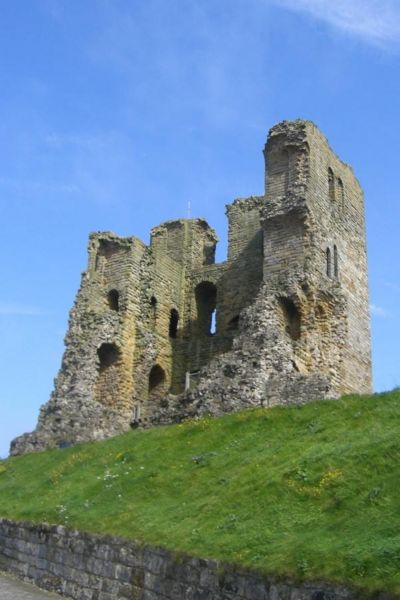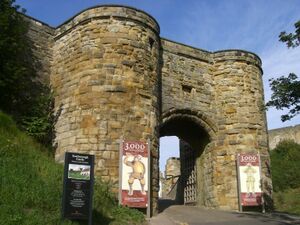Great Siege of Scarborough Castle: Difference between revisions
imported>John Stephenson (start, from Scarborough Castle) |
imported>John Stephenson (beginning of siege) |
||
| Line 1: | Line 1: | ||
{{subpages}} | {{subpages}} | ||
[[Image:Scarborough-castle-keep.jpg|thumb|right|400px|The entire west wall of [[Scarborough Castle]]'s [[keep]], as viewed from the [[barbican]] gateway, was destroyed in 1645 by [[artillery]] bombardment during the [[English Civil War]].]] | [[Image:Scarborough-castle-keep.jpg|thumb|right|400px|The entire west wall of [[Scarborough Castle]]'s [[keep]], as viewed from the [[barbican]] gateway, was destroyed in 1645 by [[artillery]] bombardment during the [[English Civil War]].]] | ||
The '''Great [[Siege]] of [[Scarborough Castle]]''' was a major conflict for control of one of [[England]]'s most important stone fortresses during the [[English Civil War]] (1642-1651), fought between the [[Oliver Cromwell]]'s [[Roundheads|Parliamentarians]] and the [[Cavalier|Royalists]] loyal to [[Charles I of England|Charles I]] (reigned 1625-1649). In 1645, Parliamentary forces laid siege | The '''Great [[Siege]] of [[Scarborough Castle]]''' was a major conflict for control of one of [[England]]'s most important stone fortresses during the [[English Civil War]] (1642-1651), fought between the [[Oliver Cromwell]]'s [[Roundheads|Parliamentarians]] and the [[Cavalier|Royalists]] loyal to [[Charles I of England|Charles I]] (reigned 1625-1649). In 1645, Parliamentary forces laid siege to the castle for five months of bombardment and bloody fighting, before its garrison finally surrendered and the last Royalist port came under Parliamentary control - a significant move in favour of [[Oliver Cromwell]]'s bid to replace the [[monarchy]] with his own [[republicanism|republican]] regime. | ||
==Background== | ==Background== | ||
| Line 9: | Line 9: | ||
==The Great Siege== | ==The Great Siege== | ||
On 18th February 1645, Sir [[John Meldrum]] took the town, cutting off any escape routes by land or sea and delivering the last Royalist port for Parliament.<ref>Page (1923).</ref> The same day, Cholmley retreated into the castle and refused to give in, so the Parliamentarians prepared for what would be a five-month siege - one of the most bloody of the Civil War, with almost continuous fighting. They were delayed for six weeks, however, while Meldrum recovered from an astonishing fall over the cliff edge; according to Cholmley, he had been trying to retrieve his [[hat]] from the wind, though the more likely explanation is that a sudden gust blew him off the cliff.<ref>Binns (1996: 150-151).</ref> | On 18th February 1645, Sir [[John Meldrum]] took the town with 1700 men and almost no casualties,<ref>Binns (1996: 131). cutting off any escape routes by land or sea and delivering the last Royalist port for Parliament.<ref>Page (1923).</ref> The same day, Cholmley retreated into the castle and refused to give in, so the Parliamentarians prepared for what would be a five-month siege - one of the most bloody of the Civil War, with almost continuous fighting. They were delayed for six weeks, however, while Meldrum recovered from an astonishing fall over the cliff edge; according to Cholmley, he had been trying to retrieve his [[hat]] from the wind, though the more likely explanation is that a sudden gust blew him off the cliff.<ref>Binns (1996: 150-151).</ref> | ||
[[Image:Scarborough-castle-barbican.jpg|thumb|right|300px|Fierce hand-to-hand fighting erupted around the [[barbican]] entrance to Scarborough Castle during the Great Siege of 1645.]] | [[Image:Scarborough-castle-barbican.jpg|thumb|right|300px|Fierce hand-to-hand fighting erupted around the [[barbican]] entrance to Scarborough Castle during the Great Siege of 1645.]] | ||
Revision as of 01:38, 7 September 2009

The Great Siege of Scarborough Castle was a major conflict for control of one of England's most important stone fortresses during the English Civil War (1642-1651), fought between the Oliver Cromwell's Parliamentarians and the Royalists loyal to Charles I (reigned 1625-1649). In 1645, Parliamentary forces laid siege to the castle for five months of bombardment and bloody fighting, before its garrison finally surrendered and the last Royalist port came under Parliamentary control - a significant move in favour of Oliver Cromwell's bid to replace the monarchy with his own republican regime.
Background
The English Civil War saw Scarborough, its castle and strategic supply port on the side of Charles I, with 700 Royalist soldiers led by Sir Hugh Cholmley - who had originally taken the castle as a Parliamentarian loyal to Cromwell in September 1642, but swapped sides in March 1643.[1] The Parliamentarians saw Scarborough as the most valuable Royalist prize because it was the only port not under their dominion; to that end, an order from the Committee of Both Kingdoms of 1st May 1645 declared that "Scarborough Castle is not so effectively besieged as were necessary for the carrying of a place of so great concernment to the public... if this could also be taken there would be no place left along all the coast for the enemy to retire unto... We consider the taking in of that Castle to be of greater consequence than any inland fort whatsoever can be... Send thither what foot forces you can spare, as they could nowhere be employed to greater advantage."[2]
Cholmley actually lost the castle in a bloodless takeover by his own cousin, Captain Browne Bushell, in March 1643 while away at York, but persuaded him to give it back.[3] The castle changed hands seven times between 1642 and 1648,[4] and was refortified on Cholmley's orders, including establishment of the the South Steel Battery for artillery.[5] Following the Royalist defeat at the Battle of Marston Moor and York's surrender to Parliament in July 1644, however, many of Cholmley's garrison deserted and the castle fell into disrepair. When Lord Fairfax's Parliamentary forces reached the edge of the town that August, Cholmley bought time to upgrade the castle defences by opening surrender negotiations, an act that would allow him to hold out for a year.[6]
The Great Siege
On 18th February 1645, Sir John Meldrum took the town with 1700 men and almost no casualties,Cite error: Closing </ref> missing for <ref> tag The same day, Cholmley retreated into the castle and refused to give in, so the Parliamentarians prepared for what would be a five-month siege - one of the most bloody of the Civil War, with almost continuous fighting. They were delayed for six weeks, however, while Meldrum recovered from an astonishing fall over the cliff edge; according to Cholmley, he had been trying to retrieve his hat from the wind, though the more likely explanation is that a sudden gust blew him off the cliff.[7]

Once Meldrum resumed command in May, the Parliamentary forces set up what was then the largest cannon in the country, the Cannon Royal, in the twelfth-century St. Mary's Church below the castle, and proceeded to fire 56-60lb (27kg) cannonballs that pounded the castle's defences.[8] In turn, the church was extensively damaged over the three days of fighting, and is partly ruined to this day; records report that Cholmley "did great mischief to St. Mary's", though it is more likely that the Parliamentary gun blasts did more damage[9] to a building that was already decaying.[10] The bombardment partially destroyed the castle keep, but without the outer walls breached, the Parliamentary forces were unable to take the castle immediately afterwards, and indeed had inadvertently supplied the defenders with a large pile of rubble that was used for cover and ammunition. The Royalists moved against the artillery battery, and the Parliamentary forces retreated in some disarray. There followed a period of particularly bloody hand-to-hand fighting around the barbican gateway, where neither side took prisoners; ultimately, Sir John Meldrum was mortally wounded.[11]
By July 1645, however, the tide was turning in the Parliamentarians' favour: Sir Matthew Boynton had replaced Meldrum, favouring cannon fire from land and sea over infantry assault. Bombardment, scurvy, lack of water, gunpowder shortages and the threat of starvation meant that the castle's surrender came on 25th July 1645, with only 25 men fit to fight. Fewer than half the original 500 defenders emerged alive, receiving a less-than-warm welcome from the townsfolk, who had endured great hardship during the siege.[12]
Aftermath
Initially repaired and rearmed for Parliament with a company of 160 to hold the castle and man the gun batteries, the castle returned to Royalist hands when the soldiers went unpaid; Matthew Boynton, its new governor and son of the elder Boynton, declared for the King on 27th July 1648.[13] This led to a second siege which brought the castle back under Parliamentary control on 19th December, with the garrison defeated as much by the oncoming winter as by the Parliamentary forces.[14] Following this, the castle was to have been demolished by an order of July 1649, to prevent it being used as a Royalist stronghold, but a local outcry saved it,[15] along with new fears that resurgent Royalist forces, aided by Frenchmen, were plotting to retake Scarborough, and the actual appearance of Dutch vessels in the harbour.[16] Instead, it was used as a prison for those deemed enemies of the Commonwealth of England, the country's brief period of republicanism; the shell of the keep survives, minus the west wall, which was destroyed in the bombardment. The castle was returned to the Crown following the restoration of the monarchy.
Footnotes
- ↑ Page (1923).
- ↑ Binns (1996: 147).
- ↑ Goodall (2000: 29-31).
- ↑ Binns (1996: 73-220); Page (1923).
- ↑ Binns (1996: 141),
- ↑ Page (1923).
- ↑ Binns (1996: 150-151).
- ↑ Goodall (2000: 29-31).
- ↑ Pope (p.13). Church booklet; St. Mary's with Holy Apostles' Church website: A Brief History of St. Mary's by Stan Pope'; Binns (1996: 165-166).
- ↑ Scarborough Archaeological and Historical Society (2003: 31).
- ↑ Binns (1996: 153-156).
- ↑ Binns (1996: 157-165).
- ↑ Binns (1996: 199).
- ↑ Binns (1996: 207-212).
- ↑ Goodall (2000: 31-32); Page (1923).
- ↑ Binns (1996: 219-220); Page (1923).